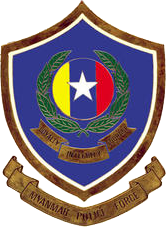Police in Myanmar
| မြန်မာနိုင်ငံရဲတပ်ဖွဲ့ | |

Official emblem
|
|
 Coat of arms |
|
| Agency overview | |
|---|---|
| Formed | 1964 |
| Superseding agency | |
| Jurisdiction | Myanmar |
| Headquarters | Naypyidaw |
| Employees | 93,000 |
| Minister responsible |
|
| Agency executive |
|
| Parent agency | Ministry of Home Affairs |
| Child agencies |
|
| Website | Official website |
The Myanmar Police Force, formally known as The People's Police Force (Burmese: ပြည်သူ့ရဲတပ်ဖွဲ့; MLCTS: Pyi Thu Yae Tup Pwe), was established in 1964 as an independent department under the Ministry of Home Affairs. It was reorganised on 1 October 1995 and informally became part of the Tatmadaw (Armed Forces of Myanmar).
The Police Force in Myanmar have an extensive history; the police force also includes local police and regional police in different jurisdictions.
The Indian Imperial Police was the primary law enforcement in Burma until 1937, when it was split from British India.
In 1872 the third mayor of Mergui District, Sir Ashly Din (1870-1875) assigned the first police officer to be stationed at Maliwan, a village 24 miles north of current Victoria Point.
Perhaps the most famous policeman in Burma from this period is the author George Orwell, who in 1922 joined the Indian Imperial Police in Burma.
On 16 March 1988 following the killing of two students during the pro-democracy demonstrations, students marching on Prome Road were confronted near Inya Lake by the Lon Htein security force riot police and many beaten to death or drowned.
The national police are made up of several smaller entities, including
The current Director General of Myanmar Police Force is Police Major General Zaw Win with its headquarters at Nay Pyi Daw. Its command structure is based on established civil jurisdictions. Each of Myanmar's seven states and seven divisions has their own Police Forces with headquarters in the respective capital cities.
...
Wikipedia
